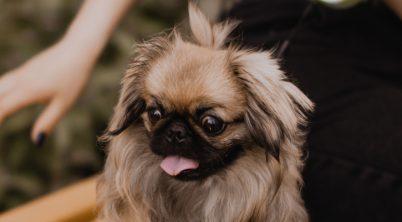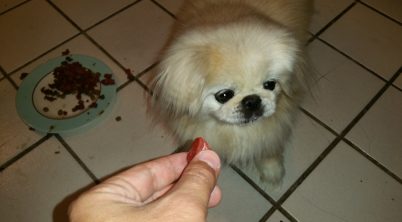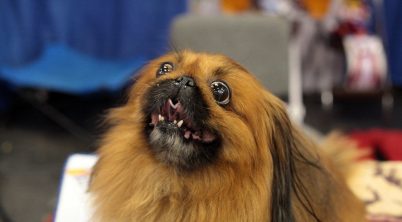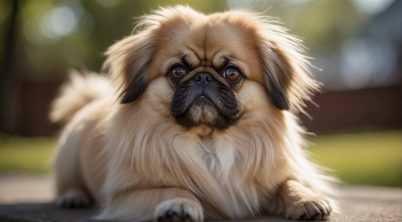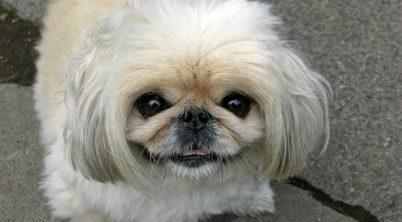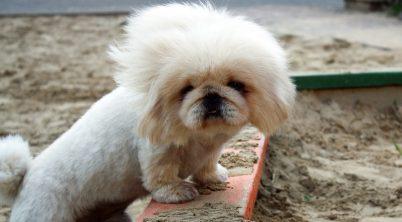The Pekingese is a small, well-composed member of the toy group that has served as a cherished companion dog for centuries. Originating in ancient China, they were a fixture in the imperial palace, with a history entwined with Chinese royalty. This breed was so esteemed that it was part of the loot taken during the Second Opium War and presented to Queen Victoria, marking their introduction to the West.
These dogs are noted for a personality that is as regal as their heritage: dignified, confident, and independent. This confidence can make them surprisingly good with other animals, including dogs, provided they have been given proper socialization from an early age. The Pekingese’s calm and polite demeanor often translates into an amiable relationship with fellow canines, particularly when they encounter those with compatible temperaments.
In a family setting, Pekingese thrive on the companionship of their human counterparts and can show a devoted nature. However, their independent streak requires patient and creative training methods. This need for respectful leadership means they may not automatically follow commands but rather cooperate based on mutual respect. Overall, the Pekingese can be a pleasant and sociable dog with others when guidance and social exposure are provided consistently.
Table of Contents
Pekingese Good with Other Dogs
Pekingese are a unique breed with distinct traits that may influence their interactions with other dogs. Known for their regal demeanor, they carry themselves with confidence and composure. When socializing Pekingese with other canines, their individual personality plays a significant role. With proper introduction and training, they can coexist peacefully with other dogs.
Socialization: Early socialization is key in helping Pekingese puppies learn to interact positively with their canine counterparts. Socialization experiences should be varied and positive, allowing Pekingese to become accustomed to different types of dogs.
Personality Matching: Much like humans, compatibility between dogs can vary. Pekingese may prefer the company of dogs with similar temperament. It’s important to observe their play style and body language to ensure a harmonious match.
Handling Dominant Behavior: Though small, Pekingese can sometimes exhibit a strong-willed nature. Managing and redirecting such tendencies is essential to foster good relationships with other pets. Providing consistent leadership and setting boundaries can mitigate any potential issues of dominance or territorial behavior.
Correcting Misconceptions: Some might think that all Pekingese prefer solitude over companionship with other dogs; however, this is not always the case. They can and often do enjoy the company of other friendly dogs if they are brought up with consistent and patient training.
By focusing on these aspects, owners can help their Pekingese navigate the complex world of dog-to-dog relationships, leading to a more sociable and well-adjusted pet.
Breed Overview
The Pekingese breed, often referred to as the “lion dog,” carries itself with a regal bearing reminiscent of its history in the Chinese imperial court. This toy companion is distinguished by a proud dignity and a self-assured presence, befitting its ancient royal lineage.
Characteristics & Appearance:
- Height: Typically 6-9 inches at the shoulder.
- Weight: Ranges from 7 to 14 pounds.
- Size: Small, compact, and stocky.
- Coat: Features a long, luxurious double coat.
- Fur: The abundant fur forms a mane around the neck, emulating the look of a lion.
- Coat Colors: Comes in various colors including gold, red, sable, cream, and black.
Pekingese dogs possess a unique appearance with their short snout, large expressive eyes, and a prominent “V-shaped” facial wrinkle. They bear a muscular and sturdy body despite their small size. The breed’s double coat, which requires regular maintenance to keep it in good condition, adds to their distinguished look.
Size & Weight Table:
| Size | Weight | Coat | Coat Color Varieties |
|---|---|---|---|
| 6-9 inches | 7-14 lb | Double-coated | Gold, Red, Sable, Cream, Black |
The Pekingese’s appearance is a testament to their esteemed origins and continues to charm enthusiasts with their distinctive silhouette and endearing qualities.
Behavior with Other Dogs and Pets
The Pekingese breed exhibits a unique set of social traits and behaviors when interacting with other dogs and pets, influenced by the dog’s socialization during the early stages. Individuals vary in temperament, but common breed characteristics set the tone for their interactions.
Social Traits
The Pekingese possess a temperament that can be both endearing and challenging. They are often good-natured with dogs and other pets they have been raised with. However, they have a reserved and sometimes aloof demeanor towards unfamiliar animals. These dogs may display independence and a self-assured attitude, which can shape the way they interact socially. It’s not uncommon for a Pekingese to be indifferent to engaging with other breeds, such as the Shih Tzu, who might share similar traits.
Early Socialization
Early socialization is crucial for a Pekingese to become well-adjusted in a multi-pet environment. Introducing a Pekingese to various companions from a young age helps to mitigate potential aggression or shyness. A properly socialized Pekingese is more likely to be receptive to other animals and adapt to living harmoniously with other household pets. Regular, gentle introductions to new dogs and experiences can form a well-rounded and less guarded pet.
Health and Care
In managing the health and well-being of a Pekingese, attention to common health issues, diligent grooming, and proper diet and exercise regimes play pivotal roles.
Common Health Issues
The Pekingese, with its distinctive brachycephalic facial structure, is prone to certain health problems. They may develop respiratory issues due to their short snout, making them more sensitive to heat and requiring a cool, ventilated environment. They often suffer from eye diseases because of their large, prominent eyes. Other potential health conditions include skin fold dermatitis and congenital heart defects. Regular check-ups with a veterinarian can help monitor and manage these concerns.
Grooming Needs
A Pekingese’s lush coat is beautiful but demands regular grooming to prevent matting and shedding. They require daily brushing to keep their coats clean and free of debris. Special attention should be given to the ears to prevent infections, as well as to the skin folds on the face to ensure they are dry and sanitary. Monthly nail trims and teeth cleanings will maintain their overall hygiene.
- Daily: Brushing, face and ear cleaning
- Weekly: Teeth cleaning
- Monthly: Nail trimming
Exercise and Diet
Despite their small size, Pekingese do not require extensive exercise. Short, manageable walks and indoor play can suffice for this toy breed. Pekingese can be prone to obesity, so it is essential to monitor their diet and provide a balanced nutrition. High-quality commercial or home-prepared food, approved by the veterinarian, coupled with limited treats, will help maintain their optimal weight. Availability of fresh water at all times is crucial for hydration, especially after exercise and during hot weather.
Training and Mental Stimulation
When training a Pekingese, it’s essential to understand that they respond best to positive reinforcement and consistent training methods. Mental stimulation is equally important to keep these intelligent dogs engaged and happy.
Effective Training Techniques
The Pekingese may display a level of stubbornness in training, thus requiring an approach that focuses on consistency and patience. Positive reinforcement, such as the use of treats or praise, proves effective in encouraging good behavior. Crate training can be beneficial for housebreaking, establishing it as a safe, comfortable space for the dog. It’s important to limit jumping during play to prevent injuries given the breed’s susceptibility to back and knee issues.
- Consistency: Repetition of commands and routines aids in reinforcing desired behaviors.
- Positive Reinforcement: Use rewards like treats and verbal praise immediately after the desired action is performed.
- Crate Training: Introduce the crate gradually as a positive space to foster secure feelings and aid in house training.
Mental Engagement Activities
A Pekingese’s intelligence demands regular mental stimulation to prevent boredom and destructive behaviors. Interactive toys, such as puzzle feeders and food-dispensing balls, cater to their playfulness and need for engagement.
- Interactive Toys: Utilize toys that stimulate the dog’s problem-solving skills.
- Training Sessions: Keep them short and engaging to maintain the Pekingese’s attention.
- Regular Playtime: Incorporate play that stimulates their mind, like hide-and-seek with treats or new tricks.
Living with a Pekingese
Living peacefully with a Pekingese requires understanding this small dog’s needs and behaviors. Pekingese are known for their alert and watchful demeanor and have qualities both charming and challenging within a household setting.
Household Adaptations
The Pekingese boasts a rolling gait and a compact size, which suits indoor living well. However, they are not just lap dogs; they appreciate short walks and outdoor play, which should be accommodated with daily routines. Family homes should include a variety of toys to keep these dogs occupied, and a crate may be used for safe containment when unsupervised, although crate time should be limited as Pekingese value their freedom and interactions with their family.
Their long, luxurious coat requires regular maintenance to prevent matting and the home should be prepared to manage shedding. Barking tendencies are present as Pekingese can be quite vocal, instinctively playing the role of a watchdog. Ensuring they are not left unattended for long periods helps minimize potential noise issues.
Household Adaptations for a Pekingese:
- Daily exercise: Short walks and playtime.
- Toys: Selection to stimulate and entertain.
- Crate Training: Important for safety, but should be balanced with free time.
- Grooming: Frequent brushing to manage shedding.
- Noise Management: Training to curb barking habits.
Interacting with Children
Pekingese can coexist with children, provided they are treated with respect and gentleness. These dogs often display a quiet and gentle nature, but their small size makes them vulnerable to rough handling, which can lead to snappy behavior if they feel threatened. Children should be taught how to interact properly with a Pekingese, making sure playtime is supervised to prevent accidental injuries to either party.
Educating family members, especially children, on the signs of a Pekingese’s discomfort (like snoring as an indicator of stress or a desire for quiet time) contributes to a harmonious living environment. Patience and calm interactions reinforce a Pekingese’s trust and affection towards the children within a family.
Tips for Interactions with Children:
- Supervision: Always monitor interactions between children and the Pekingese.
- Education: Teach children about gentle handling and recognizing the dog’s body language.
- Respectfulness: Encourage a kind approach to foster a strong, loving bond.
Finding and Choosing a Pekingese
When seeking to add a Pekingese to one’s family, prospective owners should consider both breeders and adoption options to find a healthy and well-socialized dog. The process requires attention to breed specifics and awareness of where to look for these small, regal companions historically referred to as “sleeve dogs” due to their size.
Selecting a Breeder
A responsible breeder is fundamental to finding a healthy Pekingese puppy. Sourcing from a breeder who is affiliated with the American Kennel Club (AKC) ensures that the breeder meets certain standards in the health, care, and breeding practices for Pekingese dogs. When considering breeders, potential owners should:
- Inquire about health screenings and genetic tests.
- Ask for proof of vaccinations and medical history.
- Observe the breeding environment to ensure it’s clean and the dogs are well-cared for.
Breed Colors:
- Black
- Cream
- Gray
Responsible breeders should provide detailed information about the puppy’s lineage, which includes the various coat colors like black, cream, and gray. One should expect breeders to ask questions in return, indicating their interest in the puppy’s welfare.
Adoption Considerations
Adoption offers an alternative to purchasing a Pekingese from a breeder. Prospective owners can find Pekingese dogs in need of homes at local shelters and breed-specific rescues. When adopting, they should:
- Assess the Pekingese’s behavior to ensure it is a match for their lifestyle.
- Review any available medical and behavioral history.
Adoption Benefits:
- Cost: Adoption fees are generally lower than purchasing from a breeder.
- Supporting Rescues: Provides a home to a dog in need and opens space for new rescues.
Whether adopting an adult Pekingese or a younger “Peke,” one must consider the care that these toy dogs require, including their grooming needs and social temperament. Adoption services might offer a variety of Pekingese mixes, providing options beyond the purebred standard.
* Banner photo by Kristin “Shoe” Shoemaker, cropped | Some rights reserved

